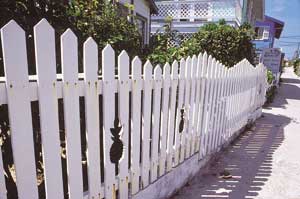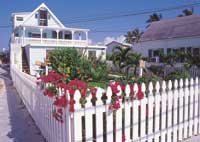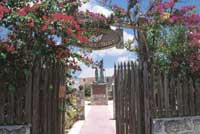| You are here: Home > Abaco Life > This Month's Features |
![]()
|
ALL THE PRETTY PICKET FENCES "Good fences make good neighbors," wrote Robert Frost in his famous poem "Mending Wall." He was an American poet, and in Abaco, nothing is more American about the island village scenery - or more neighborly - than white or natural picket fences. Wall fences were, and still are, the most common property delineation used in the British Isles, especially in rural areas. The concept of picket fences in the American colonies, particularly in New England and New York, was inspired instead by pointed iron fences in Europe, which symbolized the stately and affluent status of the home owner. But metal was expensive in the New World, and wood was abundant, so picket fences were born.
Picket fences make a bold and sturdy statement, but unlike metal and chain link fences they are not particularly intimidating. Respect for private property was a theme in Frost's poem about fences, but while they may serve at times to keep out the neighbor's dog, their main purpose in Abaco is beautification. Their standard height of only four to five feet actually invites socializing rather than discourage it. Generally, the only picket fences six feet or higher are found in backyards. The best examples of these fences today are in the settlements of New Plymouth on Green Turtle Cay and in Hope Town on Elbow Cay. But wherever they are found, construction and care still add to the home owners' status in the community, just as his garden does. Sometimes, a white picket fence blends regally with a flowing and firey bougainvillea, and different styles can express individual tastes for simplicity or ornateness.
Since paint cracks and peels as wood expands and contracts in hot and cool weather, picket fences are often whitewashed or stained rather than painted. A cedar-bleeding block primer is best applied before the stain. Some, like the fence around the Sculpture Garden in New Plymouth, are kept unfinished on purpose to minimize maintenance costs. Another technique in Abaco is the use of stainless steel nails, which won't cause rust stains on a white fence. But whatever wood or stain is used, chances are it will need touching up and redoing within three years. Fences may make good neighbors, but it's a good neighbor indeed who is willing to help with that job! |
© 2000 Abacoinfo.com All Rights Reserved.
Stories reproduced with express permission from Abaco Life.
Stories published from the Abaco
Life Magazine are © 2000 Abaco Life.
To obtain all the stories contained within this publication click
here to subscribe.

 The same
laws of supply and demand existed in Abaco when American loyalists began
arriving in 1783 to build settlements, and while a few wealthy types put
up fences of wrought iron and brass, the vast majority opted for local
cedar, and finally pine, for picket fences.
The same
laws of supply and demand existed in Abaco when American loyalists began
arriving in 1783 to build settlements, and while a few wealthy types put
up fences of wrought iron and brass, the vast majority opted for local
cedar, and finally pine, for picket fences. The crisp,
vertical lines of a picket fence have always been associated with wealth,
even though they are less expensive than chain link and most other
manufactured fence material, and, as one resident put it,
"astoundingly prettier." The wood has to brave the rain, wind
and salt air of the islands, however, making it still fairly expensive.
Pine is cheaper than cedar, but requires more maintenance.
The crisp,
vertical lines of a picket fence have always been associated with wealth,
even though they are less expensive than chain link and most other
manufactured fence material, and, as one resident put it,
"astoundingly prettier." The wood has to brave the rain, wind
and salt air of the islands, however, making it still fairly expensive.
Pine is cheaper than cedar, but requires more maintenance.